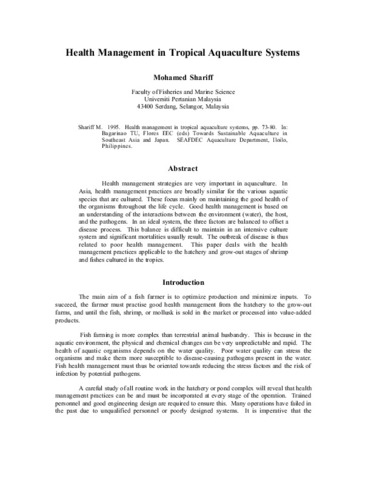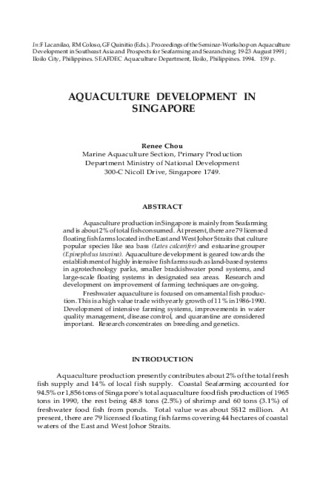Perlihatkan publikasi sederhana
Potentials of Kappaphycus striatum (Schnitz) and Gracilaria heteroclada Zhang (Ad Xia) to control the growth of luminous bacteria Vibrio harveyi
| dc.contributor.author | Tendencia, Eleonor | |
| dc.contributor.author | de la Peña, Milagros R. | |
| dc.date.accessioned | 2014-05-29T06:57:41Z | |
| dc.date.available | 2014-05-29T06:57:41Z | |
| dc.date.issued | 2010 | |
| dc.identifier.citation | Tendencia, E. A., & de la Peña, M. R. (2010). Potentials of Kappaphycus striatum (Schnitz) and Gracilaria heteroclada Zhang (Ad Xia) to control the growth of luminous bacteria Vibrio harveyi. The Philippine Agricultural Scientist, 93(1), 109-115. | en |
| dc.identifier.issn | 0031-7454 | |
| dc.identifier.uri | http://hdl.handle.net/10862/2111 | |
| dc.description.abstract | Different aquaculture species such as finfishes and bivalves have been reported to control the luminous bacterial disease of shrimp, usually caused by Vibrio harveyi. The use of seaweeds in shrimp culture system has reportedly improved water quality and reduced the bacterial count. This study evaluated the potentials of two species of seaweeds, Gracilaria heteroclada (Ad Xia) and Kappaphycus striatum (Schnitz), to control the growth of V. harveyi. V. harveyi was inoculated into control tanks containing shrimps only and into treated tanks containing both shrimp and macroalgae. Luminous bacterial counts were monitored daily. From day 2 to day 6, luminous bacterial count in tanks with G. heteroclada was significantly lower than those in tanks with K. striatum. Bacteria isolated from the rearing water containing K. striatum and G. heteroclada and from the seaweed homogenized in sterile seawater showed anti-Vibrio harveyi activity. The seaweed homogenate per se also showed anti-luminous bacterial property. Presence of both G. heteroclada and K. striatum in shrimp culture system has the potential to control the growth of luminous bacteria. G. heteroclada was more efficient and sustainable, as shown by the lower luminous bacterial count and the higher percentage recovery of this macroalga after 11 d in experimental tanks. | en |
| dc.language.iso | en | en |
| dc.publisher | University of the Philippines Los Baños | en |
| dc.subject | Gracilaria heteroclada | |
| dc.subject | Penaeus monodon | en |
| dc.subject | Philippines, Panay I., Iloilo | |
| dc.title | Potentials of Kappaphycus striatum (Schnitz) and Gracilaria heteroclada Zhang (Ad Xia) to control the growth of luminous bacteria Vibrio harveyi | en |
| dc.citation.volume | 93 | |
| dc.citation.issue | 1 | |
| dc.citation.spage | 109 | |
| dc.citation.epage | 115 | |
| dc.citation.journalTitle | The Philippine Agricultural Scientist | en |
| dc.subject.asfa | aquaculture | en |
| dc.subject.asfa | bacterial diseases | en |
| dc.subject.asfa | biological control | en |
| dc.subject.asfa | disease control | en |
| dc.subject.asfa | laboratory culture | en |
| dc.subject.asfa | luminous organisms | en |
| dc.subject.asfa | polyculture (aquaculture) | en |
| dc.subject.asfa | seaweed culture | en |
| dc.subject.asfa | seaweeds | en |
| dc.subject.asfa | shrimp culture | en |
| dc.subject.scientificName | Penaeus monodon | en |
| dc.subject.scientificName | Kappaphycus striatus | en |
| dc.subject.scientificName | Vibrio harveyi |
Files in this item
| Files | Size | Format | View |
|---|---|---|---|
|
There are no files associated with this item. |
|||
Publikasi ini ada di koleksi berikut
-
Journal Articles [1256]
These papers were contributed by Department staff to various national and international journals.




